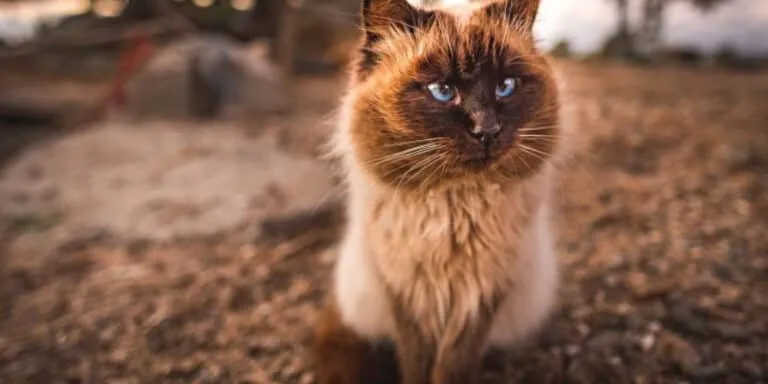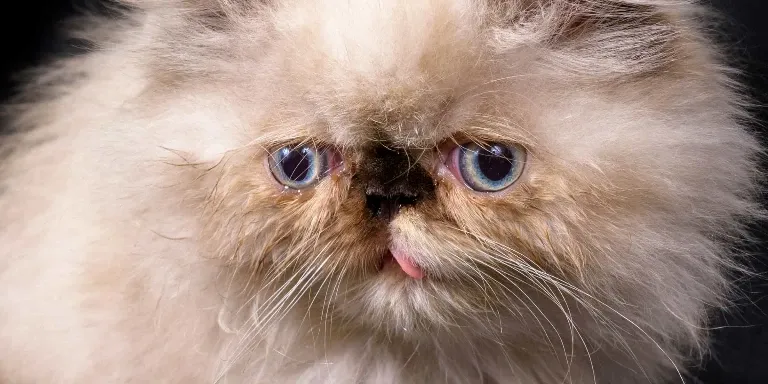The Best Fluffy Pancakes recipe you will fall in love with. Full of tips and tricks to help you make the best pancakes.

Did you know that Himalayan cats are one of the most popular cat breeds in the United States? According to the Cat Fanciers’ Association, they are the fourth most registered breed.
But what about their personality? Are Himalayan cats clingy? As a cat owner, you want to understand your pet’s temperament and behavior to ensure a happy and healthy relationship.
Himalayan cats are known for being affectionate and social with their owners, but they are not necessarily clingy. They enjoy spending time with their humans, but they also have an independent nature and do not require constant attention.
In this article, we will explore the attachment level of Himalayan cats and provide tips on how to manage a clingy cat while building a strong bond with your feline friend.
When it comes to cats, people often assume that they are independent creatures who don’t need much attention. However, just like humans, cats have their own unique personalities and preferences. Some cats may be more aloof, while others may crave attention and affection. Understanding your cat’s attachment level is crucial for providing them with the proper care and affection they need.
So, if you’re a Himalayan cat owner or considering adopting one, let’s dive into the question: are Himalayan cats clingy?
Understanding the Personality of Himalayan Cats
You’ll be amazed at how affectionate and attached Himalayan cats can be, making them the perfect cuddle buddy for those who crave constant love and attention.
These cats are known for their sweet and gentle nature, and they thrive on human company. They love to follow their owners around the house, and they will often curl up on their laps for hours on end.
Understanding grooming needs is crucial when it comes to taking care of a Himalayan cat. These cats have long, thick fur that requires daily brushing to prevent matting and tangling. Additionally, they’re prone to eye discharge, which can lead to eye infections if not cleaned regularly.
Health concerns to watch for in Himalayan cats include respiratory problems, kidney disease, and dental issues. With proper care and attention, however, these cats can live long and healthy lives.
What Does Clingy Mean for a Cat?
Feeling wanted by your feline companion is a heartwarming experience that makes any pet owner feel loved and appreciated. However, sometimes your cat’s behavior might cross the line from affectionate to clingy.
Clingy behavior in cats can be defined as persistent attention-seeking, following their owners everywhere, and wanting to be in close proximity at all times. While some cats are naturally more independent than others, clinginess can be an indication of underlying emotional issues that require attention.
Understanding cat emotions is crucial to identifying whether your Himalayan cat is displaying clingy behavior. Cats can experience anxiety, stress, and fear just like humans, and these emotions can manifest in clinginess.
If your cat is constantly seeking attention and following you everywhere you go, it might be a sign that they are feeling insecure or nervous. Alternatively, some cats might just be seeking more affection and attention than usual, which could be a result of changes in their environment or routine.
By identifying the root cause of your cat’s clinginess, you can help them feel more secure and happy in their surroundings.
Factors That Influence a Cat’s Attachment Level
Understanding the factors that influence a cat’s level of attachment is crucial in creating a stronger bond with your feline companion. Factors affecting feline attachment level can range from genetics to the environment the cat was raised in.
For instance, some breeds such as Siamese, Ragdoll, and Burmese tend to be more affectionate and clingy than others. Cats that were raised in a social and positive environment tend to be more attached to their owners and are more likely to exhibit clingy behavior.
If you find that your Himalayan cat is exhibiting clingy behavior, there are ways to reduce it. Firstly, ensure that your cat is receiving enough attention and playtime. Playing with your cat can help them release pent-up energy and reduce the need for constant attention.
Secondly, try to establish a routine for your cat. Routine can help reduce anxiety in cats and create a sense of security.
Lastly, provide your cat with a comfortable space to relax in. If your cat has a cozy bed or an area where they can retreat to when they want to be alone, they may be less likely to exhibit clingy behavior.
By understanding the factors affecting feline attachment level and taking appropriate steps, you can build a stronger bond with your Himalayan cat while reducing clingy behavior.
Do Himalayan Cats Tend to Be Clingy?
It’s common for Himalayan felines to stick to their owners like glue, often wanting to be in their laps or nearby at all times, like a shadow on a sunny day. This breed is known for its affectionate nature towards humans, which is a result of their breeding history.
Himalayan cats are a cross between Persian and Siamese cats, which gives them a unique personality that is both loving and curious. If you’re considering adopting a Himalayan cat, it’s important to understand their behavior towards humans. Here are some key points to keep in mind:
- Himalayan cats are social animals and thrive on human interaction. They often seek out attention and affection from their owners, making them one of the most clingy cat breeds.
- They have a laid-back temperament and enjoy relaxing in their owner’s lap or nearby. However, they also have a playful side and love to engage in interactive play with their humans.
- Himalayan cats are sensitive to their owner’s moods and can become stressed if they sense tension or conflict in the household. It’s important to provide them with a calm and stable environment to keep them happy and healthy.
Signs of a Clingy Cat
You may notice that your feline friend follows you everywhere, meows constantly for attention, and gets anxious when you leave the room or house if they’re a clingy cat.
Other signs of a clingy cat include demanding constant attention, being overly affectionate, and always wanting to be near you or on your lap. These behaviors can be endearing, but they can also be exhausting and frustrating if you’re someone who values your independence.
Understanding cat behavior is crucial in addressing clinginess. Cats are social animals that form strong bonds with their owners, but they also need plenty of alone time to groom themselves and relax.
It’s essential to provide your cat with plenty of playtime and toys to keep them entertained and mentally stimulated. If your cat is clingy, it’s also crucial to set boundaries and gradually teach them to be more independent.
With time, patience, and consistency, you can help your cat become more confident and self-sufficient, while also strengthening your bond with them.
How to Manage a Clingy Cat
If you have a clingy cat, there are several ways you can manage their behavior.
First, ensure that you’re providing adequate attention and playtime to meet their needs.
It’s also important to set boundaries and establish rules for when and where your cat can be with you.
Finally, if your cat is experiencing separation anxiety, there are techniques you can use to address this issue and help them feel more comfortable when you’re not around.
By following these tips, you can help your cat feel more secure and confident while maintaining a healthy and happy relationship.
Providing Adequate Attention
Ensuring that your Himalayan cat receives enough attention is crucial to prevent them from becoming overly clingy and dependent on you. One way to provide adequate attention is to schedule regular playtime for your cat. Himalayan cats are known to be playful and enjoy interactive toys.
You can set aside time each day to engage with your cat and play with them using toys such as feather wands, laser pointers, or puzzle toys. This will not only provide your cat with physical exercise but also mental stimulation.
In addition to playtime, it’s important to balance work and pet responsibilities. While it may be tempting to spend all your free time with your furry friend, it’s important to also prioritize your own needs and responsibilities. This means setting boundaries and not always giving in to your cat’s demands for attention.
Provide your cat with comfortable sleeping spaces and toys to keep them occupied while you’re away. By setting a routine and sticking to it, you can ensure a happy and healthy relationship with your Himalayan cat.
Setting Boundaries
One way to establish healthy boundaries with your furry friend is by providing them with designated spaces for sleeping and playtime. This will help them understand what areas are off-limits and what areas are their own.
For example, if you create a cozy bed for your Himalayan cat in a quiet corner of the house, they’ll learn that this is their space to relax and unwind. Similarly, if you designate a specific room or area for playtime, your cat will understand that this is where they can let loose and have fun.
Establishing boundaries is crucial for both you and your Himalayan cat. It helps prevent behavioral issues, such as separation anxiety, and creates a sense of order in the household. However, it’s important to remember that setting boundaries doesn’t mean ignoring your cat or neglecting their needs. It simply means creating a healthy balance between spending time together and giving them space to be independent.
By doing so, you’ll be able to enjoy a loving and fulfilling relationship with your Himalayan cat for years to come.
Addressing Separation Anxiety
Addressing separation anxiety can be challenging, but it’s important to understand that it’s a common issue among Himalayan cats. These felines are known for their clingy behavior and may experience distress when left alone.
Managing separation anxiety involves patience, consistency, and understanding your cat’s individual needs. Coping strategies for separation anxiety may include gradually increasing the time your cat is left alone, providing plenty of toys and activities to keep them occupied, and creating a comfortable and secure space for them to retreat to when feeling anxious.
It’s also important to establish a routine so your cat knows what to expect and feels more secure in their environment. With patience and consistency, you can help your Himalayan cat feel more comfortable being alone and reduce their separation anxiety.
Tips for Building a Strong Bond with Your Himalayan Cat
To deepen your bond with your Himalayan cat, try spending more quality time with them, petting them, and playing with their favorite toys. Here are some tips to help you build a stronger bond with your furry feline friend:
Playtime Activities:
Himalayan cats love to play, so make sure to set aside some time each day for playtime. You can use toys such as feather wands, laser pointers, or balls to keep your cat entertained.
Consider creating an obstacle course for your cat to play in. This can be as simple as stacking boxes or creating tunnels with blankets.
Interactive toys such as puzzle feeders can also provide mental stimulation and help improve your cat’s problem-solving skills.
Grooming Techniques:
Himalayan cats have long, thick fur that requires regular grooming. Brush your cat’s fur daily to prevent matting and hairballs.
Make grooming a positive experience for your cat by offering treats and praise while you brush them.
Pay attention to your cat’s body language and stop grooming if they become agitated or uncomfortable. Gradually increase the length of each grooming session to help your cat get used to the process.
By taking the time to bond with your Himalayan cat through playtime activities and grooming techniques, you can strengthen your relationship with them and create a happy, healthy home for both of you.
Are Clingy Himalayan Cats More Difficult to Take Care Of?
Clingy Himalayan cats may need more attention, but with proper himalayan cat care tips, they can be manageable. Regular grooming, a balanced diet, and mental stimulation can help keep them happy and healthy. Providing a secure, comfortable environment will also help reduce their clinginess and make them easier to care for.
Conclusion
Congratulations! You’re now equipped with a better understanding of the personality of Himalayan cats and their level of clinginess. While some cats may be more affectionate than others, there are a variety of factors that can influence their level of attachment.
If you’ve noticed that your Himalayan cat is particularly clingy, don’t worry! There are steps you can take to manage their behavior and build a strong bond with them. Remember to be patient and consistent with your efforts, and don’t hesitate to seek advice from a veterinarian or animal behaviorist if you’re struggling.
As the saying goes, “Rome wasn’t built in a day,”so don’t expect your cat’s clinginess to disappear overnight. With time and effort, you can develop a loving and rewarding relationship with your furry friend.








